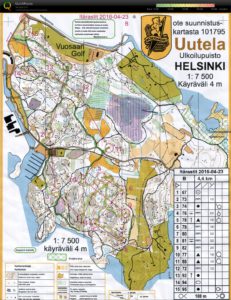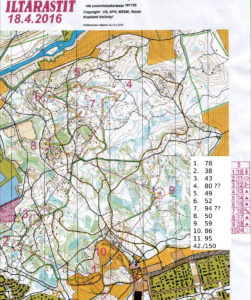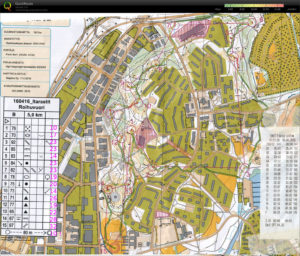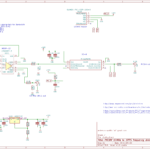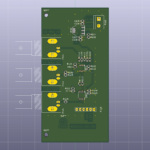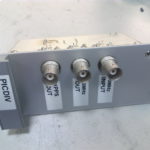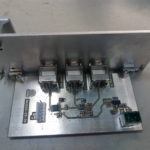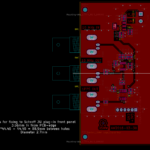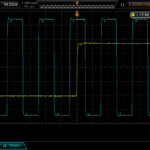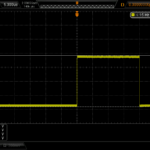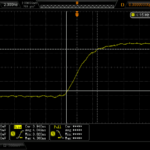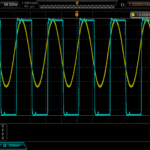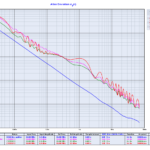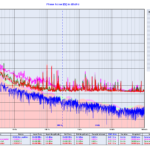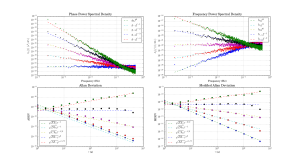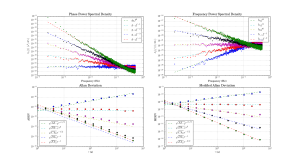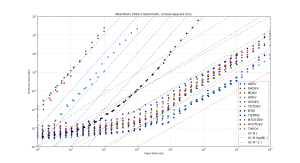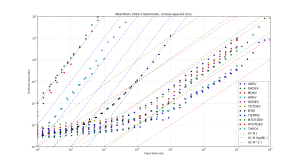got new broadband. much the same as the old broadband.
Month: April 2016
Leap second time-stamps for leap-seconds.list
This function generates time-stamps in the format used in leap-seconds.list (on e.g. NTP or PTP servers). The format is integer seconds since 1900-01-01T00:00+00.
import datetime import pytz def generate_ntp_timestamp(year,month,day,hour,minute,second): t = datetime.datetime(year,month,day,hour,minute,second,tzinfo=pytz.utc) #NTP leap-seconds list wants seconds since 1900 epoch_start = datetime.datetime(1900,1,1,0,0,0,tzinfo=pytz.utc) delta = t-epoch_start delta_s = delta.total_seconds() return int(delta_s) # test that this generates OK values. # from existing leap-seconds.list # 2918937600 27 # 1 Jul 1992 # 2950473600 28 # 1 Jul 1993 # 2982009600 29 # 1 Jul 1994 # 3029443200 30 # 1 Jan 1996 # 3076704000 31 # 1 Jul 1997 # 3124137600 32 # 1 Jan 1999 # 3345062400 33 # 1 Jan 2006 # 3439756800 34 # 1 Jan 2009 print "1 Jan 2009: ", generate_ntp_timestamp(2009,1,1,0,0,0) print "1 Jan 2006: ", generate_ntp_timestamp(2006,1,1,0,0,0) print "1 Jul 1997: ", generate_ntp_timestamp(1997,7,1,0,0,0) #output: #1 Jan 2009: 3439756800 #1 Jan 2006: 3345062400 #1 Jul 1997: 3076704000 |
Itärastit Uutela
Iltarastit Paloheinä
Itärastit Roihuvuori
PICDIV frequency divider
I put together a PICDIV frequency divider for use with a Rubidium clock.
I used an LTC6957-3 to convert the 10 MHz sine-wave from the clock to a CMOS logic signal (square wave). The LTC6957-3 has two outputs, one is routed to a BNC connector output, the other is used as the clock for a PIC12F675. The PIC runs pd09.asm which outputs a 20 us long pulse every second - i.e. it divides the 10 MHz input frequency by 1e7. The PIC is programmed through a 5-pin 100 mil ICSP header.
Here are some test-signals with a SRS PRS-10 as the source, and recorded on a Rigol scope.
The outputs behave as expected, but the 1PPS from the PIC is only 700 mVpp into 50R - a bit low. When terminated to 1 MOhm the rise-time is much worse so this is best avoided. Perhaps a buffer or level-translator would be a good addition.
Finally phase-noise measurements on the 10 MHz CMOS output, performed with a 3120A phase-noise probe.
I tried shielding the circuit with aluminium foil and powering it from a +12 VDC lead-acid battery - however the three measurement runs look roughly similar. Perhaps the LM317 regulator is not a great choice here, and both the LTC sine-to-square chip and the PIC should have more bypass caps and decoupling (inductors, ferrites?). In any case the phase-noise is 10-20x better than the measurement noise from a typical counter (SR620 or 53230A), so any issues only show up with high-end phase-noise probes.
Five colours of noise
Update: now with the colours matching in all graphs:
Time-series generated with colorednoise (following Kasdin&Walter), power-spectral-densities and Allan deviations computed with allantools, and compared to theoretical predictions in IEEE1139-2008.
The PSD lines and MDEV lines seem spot-on, but are the ADEV lines systematically a bit low?
Code here: example_noise_slopes.py
AllanTools 2016.3 benchmark
Update: a figure with more data points:
I've released AllanTools 2016.3 which now contains new mtotdev(), htotdev(), and theo1() statistics along with many other improvements. Here's a benchmark:
Compare to this one (from here):
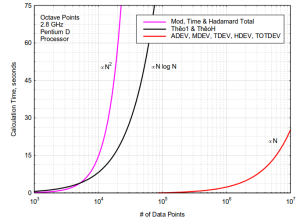 See also: numpy vs pure python comparison from 2014 August.
See also: numpy vs pure python comparison from 2014 August.

